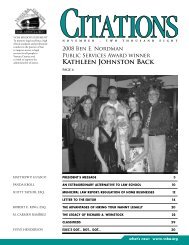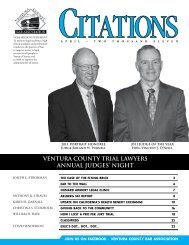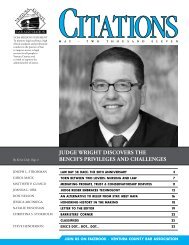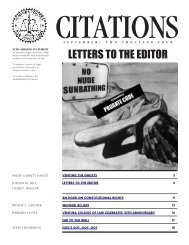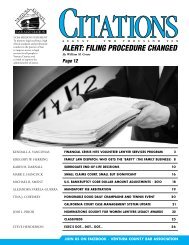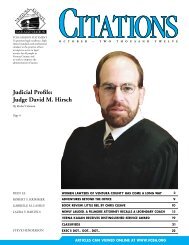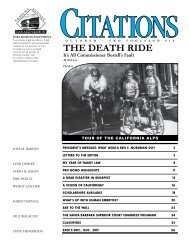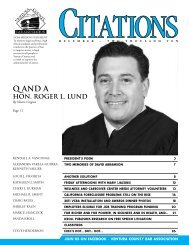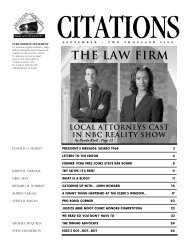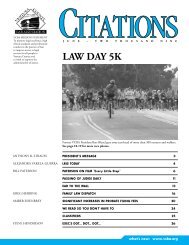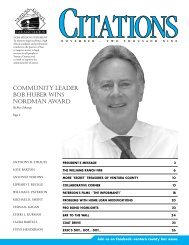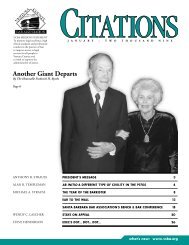March - Ventura County Bar Association
March - Ventura County Bar Association
March - Ventura County Bar Association
Create successful ePaper yourself
Turn your PDF publications into a flip-book with our unique Google optimized e-Paper software.
<strong>March</strong> 2004 • CITATIONS<br />
VCBA MISSION STATEMENT<br />
To promote legal excellence, high<br />
ethical standards and professional<br />
conduct in the practice of law;<br />
CITATIONS<br />
M A R C H – T W O T H O U S A N D F O U R<br />
To improve access to legal<br />
services for all people in<br />
<strong>Ventura</strong> <strong>County</strong>; and<br />
To work to improve the<br />
administration of justice.<br />
PHILIP GARRETT PANITZ<br />
ALFRED VARGAS<br />
ANTHONY R. STRAUSS<br />
JOHN H. HOWARD<br />
JODY C. MOORE<br />
A FACT-FINDING MISSION TO NORTH CAROLINA 3<br />
THE HISTORY OF THE JUVENILE JUSTICE COMPLEX 4<br />
VENTURA MUSIC FESTIVAL 10th ANNIVERSARY SEASON 6<br />
MASTERS IN TRIAL 7<br />
ELDER ABUSE IN OUR COUNTY 9<br />
EAR TO THE WALL / MAKE LAW NOW! 11<br />
MELISSA HILL<br />
MARK E. HANCOCK<br />
INVOKING JUDICIAL NOTICE: SOME COMMON PROBLEMS 14<br />
2003 DEVELOPMENTS IN INSURANCE LAW – PART 2 16<br />
CITATIONS SOLICITATION 20<br />
STEVE HENDERSON<br />
LOUIS J. VIGORITA<br />
EXEC’S DOT...DOT...DOT 22<br />
WE SHOULD CHANGE THE “BUNKHOUSE RULE” 24
2 CITATIONS • <strong>March</strong> 2004<br />
EULUA ACCOUNTING
A Fact-Finding Mission to North Carolina<br />
Philip Garrett Panitz<br />
<strong>March</strong> 2004 • CITATIONS 3<br />
One of the duties of<br />
the <strong>Ventura</strong> <strong>County</strong><br />
<strong>Bar</strong> Assocation Presidency<br />
is to do extensive<br />
comparative research<br />
regarding the<br />
functioning of other<br />
bar associations across<br />
our great land. This requires personal<br />
observation of other bar associations “on<br />
location.”<br />
The data I personally gather is then<br />
inserted into our <strong>Bar</strong> <strong>Association</strong>’s<br />
computer, upgrading our functionality<br />
and enhancing our ability to serve our<br />
members by “borrowing” those functions<br />
that are working better elsewhere. These<br />
time-consuming and laborious field trips<br />
to other bar associations are done solely<br />
at my own expense due to our limited<br />
budget, and are somewhat acknowledged<br />
as one of the burdens of the office. It is a<br />
tradition that has dated as far back as the<br />
Tina Rasnow administration.<br />
One of my recent fact-finding<br />
missions was to Pinehurst,<br />
North Carolina. Now, some<br />
might argue that it was the velvet green<br />
carpet of golf courses that actually led me<br />
to that far-flung locale; while others<br />
might claim that it was the coincidence of<br />
having a cousin getting married in a town<br />
just a few hundred miles away that made<br />
for a convenient excuse for the trip.<br />
I assure you that my intentions were<br />
solely in serving the bar, and in the spirit<br />
of good relations I bought the North<br />
Carolina bar presidents I played with a<br />
drink at the 19 th hole — at my own<br />
expense, of course. Although the trip was<br />
strictly business, I did book six rounds of<br />
golf at the various Pinehurst courses for<br />
those few moments when I could get<br />
away from bar functions. In fact,<br />
Pinehurst No. 2 is such a historic and<br />
famous course that I booked that course<br />
for play on three separate days.<br />
Unfortunately, it rained only three<br />
days during my visit and, as luck would<br />
have it, only on the three days I was<br />
scheduled to play Pinehurst No. 2.<br />
My cousin’s wedding was in the<br />
small town of New Bern,<br />
North Carolina. This necessitated<br />
my renting a car in New Bern and ultimately<br />
driving to Pinehurst a few days later. I<br />
rented the car from a nationally known<br />
company, which shall be forever nameless<br />
but whose name rhymes with ‘rational’ and<br />
begins with an ‘N’. I was in a hurry to get<br />
back to VCBA business, so I only took one<br />
slight sojourn to Kitty Hawk and the Outer<br />
Banks just for observational purposes. I<br />
couldn’t help but notice what an ideal<br />
location it made for perhaps our next <strong>Bar</strong><br />
Dinner.<br />
Done with my fact-finding mission, and<br />
still morose over the rain-outs on Pinehurst<br />
No. 2, I returned the rental car to the local<br />
airport in Southern Pines for the connecting<br />
flight to Charlotte and onward to Los<br />
Angeles. I was told by the sole employee at<br />
the rental counter that my bill for the week<br />
was $4,800. She informed me that I had<br />
forgotten to request unlimited miles. She<br />
also told me that I had driven the car<br />
approximately 16,000 miles in the week that<br />
I had the car. To back up her calculations,<br />
she showed me what had been written by<br />
the clerk in New Bern as the mileage on<br />
the vehicle when I had rented it. Her math<br />
was correct, the mileage that little car had<br />
upon it after my obvious misuse was in fact<br />
16,000 miles more than what had been<br />
written on my contract.<br />
At first the shock dislodged all<br />
cognitive reasoning functions in<br />
my brain, but once my synapses<br />
started firing again, I questioned her<br />
calculations. The driving distance between<br />
New Bern and Pinehurst was maybe 200<br />
miles, and the side trip to Kitty Hawk added<br />
another 250 at the most. The entire time at<br />
Pinehurst I had stayed at the resort, which<br />
had a shuttle bus. I argued that I had put 600<br />
or 700 miles on the car at the top end. She<br />
stuck to her guns, and insisted that I sign her<br />
papers. I refused. We were at a standoff<br />
when she called her headquarters to get<br />
further directions.<br />
While she did so, I did some quick<br />
calculations in my head. The total of 16,000<br />
miles divided by seven days meant that I<br />
would have to have driven the car an<br />
average of 2,286 miles per day. Since there<br />
are only 24 hours in a day, I would have<br />
been driving an average of 95 miles per<br />
hour for 24 hours straight all seven days to<br />
make that kind of mileage.<br />
Some of you who know me might not<br />
question the 95 miles per hour part, but the<br />
rental car was a Geo Metro, not my<br />
Porsche. Besides, I do need to stop to eat,<br />
sleep, and occasionally perform other<br />
functions — although as I get older,<br />
perhaps less and less. This would<br />
necessitate taking that Geo Metro over the<br />
century mark to make up for lost time. I am<br />
not sure that car could have reached a mile<br />
over 60 m.p.h., quite frankly.<br />
When presented with this data, her<br />
headquarters realized that someone had<br />
made some kind of dreadful mistake, and it<br />
wasn’t me. They agreed to look into it, but<br />
insisted that I sign my credit card for 10%<br />
of the total, or $480. It was completely<br />
arbitrary and excessive, but not wanting to<br />
miss my plane, I signed it under protest. I<br />
wrote to the car rental company upon my<br />
return home and also the credit card<br />
company, and ultimately was refunded my<br />
entire $480.<br />
It’s a tough job being President, but<br />
someone has to do it. It might also help to<br />
check the mileage when you first rent<br />
the car.<br />
— : —<br />
Philip Garrett Panitz, 2004 President of the<br />
<strong>Ventura</strong> <strong>County</strong> <strong>Bar</strong> <strong>Association</strong>, specializes in<br />
corporation and tax law.
4<br />
CITATIONS • <strong>March</strong> 2004<br />
The Judge Steven Z. Perren Juvenile Justice Complex — Alfred Vargas<br />
The outskirts of Sacramento, 1999.<br />
<strong>Ventura</strong> <strong>County</strong> Presiding Juvenile Court<br />
Judge Steven Perren sat at the bar of a<br />
lonely motel with tumbleweeds for<br />
neighbors. He pondered the 10-minute<br />
performance he was about to give. In<br />
retrospect, according to him, it would be<br />
the most important of his life.<br />
He had just witnessed another delegation<br />
make its plea for a slice of the $138<br />
million the federal government had allotted<br />
California to update county detention<br />
facilities. Judge Perren realized he had to<br />
rework his speech, and quickly.<br />
At stake was $40.5 million to build a<br />
new juvenile complex. Cal Remington,<br />
Don Krause, Karen Staples, and Joan<br />
Splinter of the Probation Department had<br />
assembled a proposal and presentation for<br />
the Corrections Board. They were competing<br />
with delegates from 38 other counties,<br />
yet the <strong>Ventura</strong> <strong>County</strong> delegation was<br />
asking for thirty percent of the total allotted<br />
funds.<br />
When they completed their presentation,<br />
Judge Perren spoke. Some were<br />
moved to the point of tears. One delegate<br />
from another county walked up to Judge<br />
Perren afterwards and embraced him. The<br />
Board was equally moved; <strong>Ventura</strong> <strong>County</strong><br />
was awarded its request in full.<br />
Juvenile Facilities<br />
The justice system deals with juveniles<br />
in dependency and delinquency courts.<br />
Dependency court wards come into the<br />
state’s custody through no fault of their<br />
own, usually because of abuse or neglect<br />
by guardians. The Clifton Tatum Center is<br />
an 84-bed co-ed juvenile hall designed as a<br />
predisposition facility for dependency<br />
wards awaiting foster homes or other<br />
placement, but it has also been used to<br />
provide temporary custody of minors in<br />
need of short-term removal from the<br />
community.<br />
Delinquency court wards come<br />
into the system because of a<br />
criminal act or status offense such<br />
as habitual truancy, curfew violations,<br />
failure to obey parents, or<br />
being a runaway. The Colston<br />
Youth Center is a 45-bed juvenile<br />
detention facility where delinquency<br />
wards may be incarcerated<br />
for three to six months.<br />
New Complex Needed<br />
The sad truth is that even<br />
after two million dollars in renovations<br />
over the years to correct earthquake<br />
damage and general deterioration,<br />
the old facilities were still woefully<br />
inadequate. The Clifton Tatum<br />
Center is literally sinking into the<br />
ground. There are tales of loose<br />
wires and other dangerous conditions,<br />
not to mention overcrowding.<br />
Pam Grossman, Senior Deputy<br />
D.A. for the juvenile unit, reports<br />
that she has used photographs of<br />
these facilities at intervention and<br />
truancy meetings to illustrate to<br />
kids that the path they were on would lead<br />
to very bad things. Parents of these kids<br />
say this was enough to scare some youths<br />
into changing their behavior.<br />
When asked what should be done with<br />
the old juvenile hall, a very somber<br />
Juvenile Court Presiding Judge Back<br />
would only say, “It needs replacing.”<br />
The New Facility<br />
The Board of Supervisors<br />
honored now-Justice Perren in June<br />
of 2001 at the ground-breaking<br />
ceremony of a new juvenile center. It<br />
is named the Judge Steven Z. Perren<br />
Juvenile Justice Complex. The<br />
196,000-square-foot facility sits on<br />
a 45-acre parcel off Vineyard Ave.,<br />
north of Highway 101. It has 420<br />
beds.<br />
By mid-<strong>March</strong> of this year the<br />
populations of both the Clifton<br />
Tatum Center and the Colston Youth<br />
Center will be moved into the new<br />
complex. All the treatment programs that<br />
were administered in the old buildings will<br />
be housed under one roof. Counselors,<br />
therapists, and teachers will work in the<br />
new facility.<br />
Each of the living units has its own<br />
classroom and exercise area. Also available<br />
are a large gym and a technology<br />
training center. In addition the complex<br />
has medical offices, a visitor center,<br />
kitchen, laundry facilities, and offices for<br />
education and facility programs. The<br />
complex resembles a college dormitory<br />
more than it does an institutional facility.<br />
Some parts of the complex have comfortable<br />
armchairs in front of television sets.<br />
There are also tabletop amusement games<br />
such as chess and ping-pong.<br />
However, the college campus illusion is<br />
shattered by peering into one of the<br />
individual sleeping rooms. Each has a<br />
concrete shelf for a mattress and the<br />
brushed-steel toilet/sink combination indicative<br />
of a correctional institution.
<strong>March</strong> 2004 • CITATIONS 5<br />
New Courtrooms<br />
<strong>Ventura</strong> <strong>County</strong> will have six new<br />
courtrooms adjacent to the juvenile<br />
complex: two dependency courtrooms,<br />
two delinquency courtrooms, and two<br />
general trial courtrooms that will accommodate<br />
juries. The 45,000-square-foot<br />
court building will be completed in July<br />
2004 and is minutes away from the<br />
juvenile center by tunnel.<br />
Judges Brian Back, Charles Campbell,<br />
and John Dobroth will relocate to the new<br />
courthouse. Michael Planet, Executive<br />
Officer of the courts, says there are no<br />
immediate plans to transfer anyone else to<br />
the new facility.<br />
The move will leave vacant three<br />
courtrooms at the Hall of Justice.<br />
Courtrooms 36 and 37 have jury boxes,<br />
while courtroom 30, the Dependency<br />
Court, will need renovation before it can<br />
be used as a trial court. However, since the<br />
population of <strong>Ventura</strong> <strong>County</strong> has not<br />
increased to allow for new judicial<br />
appointments, these will remain vacant.<br />
The new courthouse will accept<br />
payments for traffic fines but will not<br />
accept court filings.<br />
If you build it, will they come<br />
Opponents of any new juvenile detention<br />
facilities argue that if the beds are<br />
available, the justice system will fill them<br />
with our youth and thus more kids will be<br />
institutionalized.<br />
While the number of beds available for<br />
juveniles has jumped from 130 to 420, and<br />
will expand to 540 in the future, this<br />
facility is designed to eventually meet the<br />
needs of the county’s population through<br />
2050.<br />
The old juvenile hall was built fifty<br />
years ago at a time when the county’s<br />
population was about 150,000. Just<br />
because it has 85 beds does not necessarily<br />
mean that there are only 85 juveniles in<br />
need of intervention. Today there are five<br />
times as many people in the county as in<br />
1955, with a population jump of at least<br />
10% every ten years.<br />
The goal is not to incarcerate these kids<br />
because there is room to do so. According<br />
to Justice Perren, the goal is to remove<br />
them, where necessary, from their current<br />
Santa <strong>Bar</strong>bara Bank &<br />
Trust ad<br />
Continued on page 10
6<br />
CITATIONS • <strong>March</strong> 2004<br />
<strong>Ventura</strong> Music Festival Tenth-Anniversary Season<br />
Anthony R. Strauss<br />
Although many people<br />
are unaware of it, the<br />
City of <strong>Ventura</strong> plays<br />
host to an annual worldclass<br />
music festival each<br />
spring. The <strong>Ventura</strong><br />
Music Festival, which<br />
runs over a ten-day span<br />
during the first week in May, is celebrating<br />
its tenth anniversary this year.<br />
In past years, we have had worldrenowned<br />
notables, such as classical<br />
guitarists Christopher Parkening and Pepe<br />
Romero, classical pianist Alicia de<br />
Larrocha, and jazz pianist David Benoit,<br />
performing classical, jazz, blues, and other<br />
types of music in historic venues in<br />
Downtown <strong>Ventura</strong>.<br />
New Artistic Director<br />
Takes Up the Baton this Year<br />
In addition to celebrating its Tenth-<br />
Anniversary Season, this year’s Festival<br />
sees the arrival of a new artistic director,<br />
Navroj Mehta. Mehta — a violinist, and<br />
cousin of the internationally recognized<br />
conductor Zubin Mehta — also serves as<br />
music director for a variety of symphony<br />
orchestras, which gives him the ability to<br />
draw on his personal contacts with many<br />
of the world’s premier musicians in order<br />
to benefit the Festival.<br />
The Tenth Anniversary has given us the<br />
opportunity to preview the Festival with<br />
events scheduled every month since<br />
August. The event in January featured<br />
Mehta on violin and Cuban pianist Santiago<br />
Rodríguez performing works by American<br />
composers in the beautiful adobe <strong>Ventura</strong><br />
Community Presbyterian Church.<br />
But the evening didn’t end there; those<br />
fortunate enough to take advantage of the<br />
intimate after-party at the hillside villa of<br />
Stephen and Lynn Kipp were treated to fine<br />
wine and delectable food, culminating with<br />
both Mehta and Rodríguez performing<br />
before captivated guests.<br />
Members of the <strong>Bar</strong> <strong>Association</strong><br />
Are Active in the Festival<br />
Some of our colleagues are initiates of the<br />
<strong>Ventura</strong> Music Festival world. Judges<br />
Roland Purnell and Bill Peck, along with<br />
Larry Matheney, Tom Hinkle, Peter<br />
Goldenring, Bill Fairfield, Donna De<br />
Paola, Al Contarino, Dick Chess, and I<br />
are Founders of the Festival. Regular<br />
attendees and contributors include Judges<br />
Vince O’Neill and Fred Bysshe, Don<br />
Benton, Wendy Lascher, Melissa<br />
Cohen, Mike O’Brien, Melody<br />
Kleiman, Michael Case, Bruce Crary,<br />
Jim Griffin, Mary Howard, Michael<br />
Kelly, Dan Palay, and Bill Moritz.<br />
As well as providing a forum for<br />
listening to wonderful music performed by<br />
some of the world’s greatest musicians, the<br />
Festival’s mission also includes education.<br />
Mehta has visited approximately ninety<br />
third-grade classes in <strong>Ventura</strong> and Oxnard<br />
to introduce children to the concept of<br />
melody and the creation of music. He has<br />
also held master-class workshops for<br />
middle and high school students.<br />
This year’s Festival, entitled<br />
“Celebration of the Americas,” runs from<br />
April 29 through May 9, and will include<br />
performances by Chris Brubeck and Triple<br />
Play, Santiago Rodríguez, the Vermeer<br />
String Quartet, Eddie Daniels, Paul<br />
Galbraith, and Dmitri Demiashkin. For<br />
ticket information, contact the <strong>Ventura</strong><br />
Music Festival <strong>Association</strong> at<br />
(805) 648-4103 or visit<br />
www.venturamusicfestival.org.<br />
— : —<br />
Anthony R. Strauss, of Strauss-Uritz, is President<br />
of the <strong>Ventura</strong> Music Festival.
<strong>March</strong> 2004 • CITATIONS 7<br />
Masters in Trial<br />
John H. Howard<br />
On Friday, <strong>March</strong> 26, 2004,<br />
area lawyers will have a rare<br />
opportunity to experience a live<br />
trial demonstration by renowned<br />
civil trial lawyers from California<br />
and around the nation. The<br />
California Coast Chapter of the<br />
American Board of Trial<br />
Advocates (ABOTA) is sponsoring this<br />
one-day event, at which twelve trial<br />
lawyers, six each for the plaintiff and<br />
defendant, will examine live witnesses and<br />
argue their case before an actual jury,<br />
presided over by Associate Justice Paul H.<br />
Coffee of the Second District Court of<br />
Appeal.<br />
This Masters in Trial program is similar<br />
to programs periodically presented around<br />
the country and featuring ABOTAmember<br />
panelists who volunteer their time<br />
and pay their own expenses. The last<br />
Masters in Trial program conducted locally<br />
was in 1997. A unique feature of this event<br />
will be a live video feed of the jury’s<br />
deliberations in an adjoining room.<br />
This year’s participants include Thomas<br />
V. Girardi, Bruce A. Broillet, Browne<br />
Greene, Robert C. Baker, Edward<br />
J. Nevin, Donna Melby, and<br />
others. It will be presented at Fess<br />
Parker’s Doubletree Resort in<br />
Santa <strong>Bar</strong>bara.<br />
Attendees will receive 7.25<br />
hours of continuing legal<br />
education credit, including one<br />
hour of legal ethics. The registration form<br />
for this program is enclosed in this edition<br />
of CITATIONS and is posted on ABOTA’s<br />
website at www.abota.org, together with<br />
information about ABOTA and other<br />
Masters in Trial programs. You may also<br />
contact Elaine Flynn, director of<br />
Professional Education, ABOTA<br />
Foundation, at (800) 779-5879, or by e-<br />
mail at elainef@abota.org.<br />
For more information on the California<br />
Coast Chapter’s <strong>March</strong> 26 th Masters in<br />
Trial program, you may contact Evelyn<br />
Downs, legal assistant to Craig Price<br />
of Griffith & Thornburgh LLP, at<br />
downs@g-tlaw.com.<br />
— : —<br />
John H. Howard is President of the California<br />
Coast Chapter of ABOTA.
8<br />
CITATIONS • <strong>March</strong> 2004<br />
Divine Hall<br />
Pacific Coast Reporters
<strong>March</strong> 2004 • CITATIONS 9<br />
Elder Abuse in Our <strong>County</strong> — Jody C. Moore<br />
In January of 2004,<br />
Attorney General Bill<br />
Lockyer released an<br />
important report in<br />
conjunction with State<br />
of California Department<br />
of Justice Bureau<br />
on Medi-Cal Fraud<br />
and Elder Abuse. The report inspected<br />
nursing homes in 16 counties in the state of<br />
California, with an eye to improving the<br />
quality of care for elderly and dependentadult<br />
residents by identifying and correcting<br />
violations of applicable federal, state,<br />
or local laws and regulations.<br />
<strong>Ventura</strong> <strong>County</strong> was included in the<br />
study. Six nursing homes were inspected<br />
and the results were published in the 400-<br />
plus page report. You may have read a<br />
blurb about it in the <strong>Ventura</strong> <strong>County</strong> Star<br />
on January 22, 2004. But the newspaper<br />
account glossed over the evidence of elder<br />
abuse by referencing trivial findings such<br />
as rotting olives outside a facility and torn<br />
window screens. The real stories are about<br />
profound malnutrition, seriously infected<br />
bedsores rotting away flesh down to the<br />
bone, contractures which rob the elderly<br />
of their mobility, and diapering residents<br />
for staff convenience rather than based on<br />
the abilities of the residents.<br />
The root cause of these problems is that<br />
the facilities are horribly understaffed.<br />
Staffing was a large component of the<br />
attorney general’s findings. In fact, four<br />
out of six of the <strong>Ventura</strong> <strong>County</strong> facilities<br />
surveyed are not in compliance with the<br />
mandatory minimum state staffing<br />
requirements. Yet the facilities continue<br />
to operate in violation of the law because<br />
there are few, if any, consequences.<br />
Few cases of elder abuse and neglect<br />
are prosecuted, either criminally or<br />
civilly. Many families complain about<br />
incidents of abuse. They complain to<br />
facilities; they complain to the local<br />
ombudsman’s office; they complain to<br />
attorneys. Very often their stories go<br />
unheard. There are always problems of<br />
proof when dealing with elderly,<br />
demented, frail clients. Often the victim<br />
of the elder abuse has passed away and<br />
there is no “witness” to explain the<br />
suffering associated with the neglect.<br />
There are financial disincentives to<br />
prosecute claims on behalf of the elderly<br />
because special damages are limited, if<br />
they exist at all.<br />
Despite these hurdles, it is important for<br />
us to raise awareness of abuse in our<br />
community. We should not dismiss client<br />
complaints regarding quality of care. We<br />
should not expect perfection in nursing<br />
homes. But we should expect compliance<br />
with the law. Many elderly nursing home<br />
residents are not granted even that dignity.<br />
I fear that the <strong>Ventura</strong> <strong>County</strong> Star<br />
article left our community with the<br />
impression that urine smells and buzzing<br />
flies are the most serious problems facing<br />
the elderly in nursing homes. Please help<br />
me raise awareness of the true stories of<br />
neglect which occur in our county<br />
facilities. Only by giving the victims of<br />
elder abuse a voice can we hope to avoid<br />
future abuses.<br />
— : —<br />
Jody C. Moore specializes in nursing home and<br />
elder-care-facility litigation based on elder abuse and<br />
neglect.<br />
Wood and Binder
10 CITATIONS • <strong>March</strong> 2004<br />
Juvenile Justice Center<br />
Continued from page 5<br />
predicament — whether it’s gangs, drugs,<br />
or their household situations. This breaks<br />
the downward spiral and allows a child to<br />
attend school, counseling, or receive<br />
substance-abuse treatment. The system<br />
gives children sanctuary and an opportunity<br />
to participate in programs that develop<br />
life skills necessary to function in society.<br />
Answering the criticism that we may<br />
lock up more juveniles, Justice Perren says<br />
that some of them, unfortunately, need to<br />
be locked up. By their behavior they have<br />
demonstrated they are a danger to<br />
themselves and to those around them.<br />
Through intervention we can stop them<br />
from self-destructing and perhaps protect<br />
a future victim. These are children who<br />
“haven’t figured it out yet. It is our job to at<br />
least try to help them with our best efforts<br />
until they turn 18. If we can’t help them,<br />
they are on their way to becoming<br />
residents of our adult penal system.”<br />
— : —<br />
VON HANEL<br />
Alfred Vargas is an associate<br />
at Lascher & Lascher, handling<br />
appeals, writs, and trial court<br />
motions. He is a member of the<br />
CITATIONS Board.<br />
Phillip<br />
Feldman<br />
Verdict Resources
<strong>March</strong> 2004 • CITATIONS 11<br />
Ear to the Wall<br />
Noble & Associates<br />
FIRST NATIONAL<br />
T. C. Attorney at Law<br />
Law Offices of Joseph J. Beltran have<br />
relocated the Oxnard office to 3585 Maple<br />
Street, Suite 270, <strong>Ventura</strong>, 93003.<br />
Telephone (805) 650-2077 and fax (805)<br />
650-2079.<br />
Edsall & Norris has relocated their office<br />
from its previous Camarillo address to 751<br />
Daily Drive, Suite 325, Camarillo, CA<br />
93010. The telephone and fax numbers<br />
remain the same. The attorneys in the firm<br />
include: David E. Edsall, Gary W.<br />
Norris and Timothy S. Camarena, with<br />
Jerry L. Freedman, of counsel.<br />
The law firm of Van Sickle and Rowley,<br />
LLP is pleased to announce that Rein<br />
Perryman has joined the firm as an<br />
associate attorney. Ms. Perryman will<br />
divide her time between the Family Law<br />
Department and the Business Services<br />
Group.<br />
Santa <strong>Bar</strong>bara law firm Cappello &<br />
McCann LLP has changed names and<br />
added a new partner, according to managing<br />
partner A. <strong>Bar</strong>ry Cappello. The new<br />
name is Cappello & Noël LLP and reflects<br />
the decision to add partner Leila J. Noël<br />
to the firm name and the departure of<br />
Michael W. McCann, who has begun a<br />
solo legal practice. In addition, Troy A.<br />
Thielemann, an associate with the firm<br />
since 1996, has become a partner. On the<br />
web at: www.cappellonoel.com. E-mail:<br />
info@cappellonoel.com.<br />
The Law Library has a list of books up for<br />
bid in <strong>March</strong>. Come in and pick up a copy<br />
of the list or call and ask to be put on our<br />
mailing list. (805) 642-8982.<br />
— : —<br />
Make Law Now!<br />
Robert Gardner<br />
If you are interested in joining VCBA’s<br />
State <strong>Bar</strong> delegation (see December 2003<br />
CITATIONS), please contact Melissa Hill<br />
at MelissaJ.Hill@mail.co.ventura.ca.us or<br />
477-1954. Remember: this email address<br />
must not be used to communicate about<br />
any matters before the court or anything<br />
else except delegation-related matters.<br />
— : —
12 CITATIONS • <strong>March</strong> 2004<br />
<strong>Bar</strong>ry Cane<br />
INSURANC<br />
G. W. Kenny
<strong>March</strong> 2004 • CITATIONS 13<br />
E SPREAD<br />
Lawyers Mutual<br />
Winner & Associates Agency
14 CITATIONS • <strong>March</strong> 2004<br />
Invoking Judicial Notice: Some Common Problems — Melissa Hill<br />
Sections 451 and 452<br />
of the Evidence Code<br />
set out which things are<br />
judicially noticeable.<br />
See also Weil & Brown,<br />
California Practice<br />
Guide: Civil Procedure<br />
Before Trial (Rutter<br />
Group 2002), at 7:18 et seq. It’s a good<br />
idea to review the statutes and a practice<br />
guide before asking a court to take judicial<br />
notice. With increasing frequency we<br />
research attorneys are seeing requests for<br />
judicial notice where it is unnecessary or<br />
simply impossible.<br />
Most often judicial notice is sought<br />
in connection with a demurrer.<br />
When ruling on a demurrer, the<br />
court may consider only those matters stated<br />
on the face of the subject pleading, and<br />
matters judicially noticeable. Often attorneys<br />
request judicial notice of the very<br />
pleading that is under attack. Of course the<br />
outcome of the demurrer depends on the<br />
sufficiency of that pleading, and the court<br />
will review it anyway. There’s no need to<br />
request judicial notice of the complaint or<br />
answer one is demurring to.<br />
Attorneys moving for summary judgment<br />
or summary adjudication similarly often<br />
request judicial notice of the operative<br />
pleading. Again, the issues are framed by<br />
that pleading. The court will be reviewing<br />
its allegations in the course of deciding the<br />
MSJ or SAI motion. It is not necessary to<br />
request judicial notice. That being said, the<br />
court always welcomes a copy of the complaint<br />
or applicable pleading, especially in<br />
multi-volumed cases. Attaching a copy of<br />
the complaint as an exhibit can save the<br />
court time, and save a weary deputy clerk<br />
another trip to Legal Research or chambers<br />
to deliver the one missing volume of a multivolumed<br />
case.<br />
Attorneys also ask for judicial notice of<br />
matters that simply are not judicially noticeable.<br />
I have seen requests for judicial<br />
notice of correspondence, of discovery responses,<br />
and, once, of a phone message.<br />
The erring attorney can save much face by<br />
advance review of the Evidence Code. If a<br />
demurrer depends on facts in the extraneous<br />
document which are not proper subjects<br />
of judicial notice, there’s no point in<br />
consuming time and money on it.<br />
Don’t forget that although the court<br />
may take judicial notice of certain<br />
types of documents filed in<br />
other cases, it cannot accept as true the<br />
contents of those documents. We often see<br />
requests for judicial notice of documents<br />
or exhibits attached to previously filed<br />
motions, or those filed in other cases, and<br />
it is clear from counsel’s arguments that<br />
counsel is expecting to have the contents<br />
taken as true and in this way win his or her<br />
motion.<br />
Take a moment to consider the difference.<br />
Is the matter for which you are seeking<br />
judicial notice a judgment or final<br />
order Then its contents might well be<br />
taken as true. On the other hand, are you<br />
seeking judicial notice of an exhibit, or a<br />
pleading, or a declaration, or a motion<br />
filed in some other case Don’t rely on<br />
the statements made in another motion to<br />
support the motion you’re bringing here.<br />
Again, a brief review of the applicable<br />
rules and law can keep you on track.<br />
There are other considerations to be<br />
made when seeking judicial notice. First,<br />
though it’s not required by statute, you<br />
do well to bring a request separately from<br />
your motion. That is, if you merely request<br />
judicial notice in the body of your motion<br />
or demurrer, you stand the chance of<br />
West Group<br />
Gregg Kravitz<br />
having it overlooked. If on the other hand<br />
you bring it separately, both the research<br />
attorney and the judge will likely deal with<br />
the request first before moving on to the<br />
motion. The court will appreciate this<br />
method because it avoids the frustration<br />
of working partway through a motion only<br />
to have to go back and reconsider already<br />
considered arguments after stumbling<br />
across a request for judicial notice buried<br />
halfway through the moving papers.<br />
Finally, be sure the material for which<br />
you seek judicial notice is delivered<br />
to the court for its consideration.<br />
This means that if you are seeking judicial<br />
notice of documents, provide authenticated<br />
documents as exhibits to the<br />
request. If you are seeking judicial notice<br />
of another file in the same court, make sure<br />
you arrange for that other file to be delivered<br />
to chambers prior to the hearing.<br />
Most helpful are those attorneys who<br />
make this request when they file the motion<br />
and include some sort of clear written<br />
request to the clerks — so that when<br />
the calendar clerks are pulling files, they<br />
notice the request and know to bring both<br />
files. CRC Rule 323 requires the party to<br />
make sure the clerk has the other file in the<br />
courtroom at the time of the hearing. How-
<strong>March</strong> 2004 • CITATIONS 15<br />
ever, since we know the court reviews the<br />
motions several days prior to the hearing,<br />
you will want to ask the clerk’s office to<br />
deliver the second file along with the main<br />
file so it can be analyzed in the regular<br />
course of review. It’s more difficult when<br />
one is requesting judicial notice of a file<br />
from another jurisdiction.<br />
It’s surprising how often an attorney will<br />
request such notice, yet fail to obtain either<br />
certified copies of the subject documents<br />
or to subpoena the file from the other court.<br />
Of course there’s no way the court can take<br />
notice of the other file, much less consider<br />
the contents of a final order or judgment in<br />
that other file, if the materials are not delivered<br />
to the court.<br />
We attorneys are busy folk. Litigators<br />
have too few hours in each day, and too<br />
few days in the billable month. Yet we do<br />
well to remember that a bit more attention<br />
to the codes, the Rules of Court, and to<br />
detail can save time, money, and the frustration<br />
that comes from a motion denied<br />
because we didn’t fully understand the<br />
rules attendant to seeking judicial notice.<br />
— : —<br />
Melissa Hill is a research attorney for the <strong>Ventura</strong><br />
<strong>County</strong> Superior Court.<br />
Business Appraisal<br />
Lawyer Referral
16 CITATIONS • <strong>March</strong> 2004<br />
2003 Developments in Insurance Law – Part 2<br />
Mark E. Hancock<br />
This is the second part<br />
of a two-part article.<br />
Part 1 appeared in the<br />
February 2004 issue<br />
of CITATIONS and<br />
presented recent developments<br />
in ERISA and<br />
in insurance subjects<br />
ranging from advertising injury to rescission.<br />
This installment covers punitive damages,<br />
focusing on the case of State Farm Mutual<br />
Auto Insurance Co. v. Campbell (2003) 538<br />
U.S. 408 (123 S.Ct. 1513, 155 L.Ed.2d 585).<br />
One couldn’t write an article on<br />
insurance-related developments in 2003<br />
without mentioning State Farm v.<br />
Campbell. This case is important for its<br />
discussion of the guideposts for reviewing<br />
a punitive damage award, the kinds of<br />
evidence allowable in the determination of<br />
punitive damages, and the limits on such<br />
damages. It arose from State Farm’s<br />
mishandling of a third-party auto liability<br />
claim in the State of Utah.<br />
Punitive Damages —<br />
How Much is Enough<br />
To appreciate the Campbell case, a<br />
little context would be useful. Although<br />
there are those who would like to do away<br />
with punitive damages entirely, they are an<br />
established part of American tort law. For<br />
example, by 1935, all states, with the exception<br />
of Louisiana, Massachusetts, Nebraska<br />
and Washington, had adopted some<br />
form of punitive damage remedy. It has<br />
been a feature of English law for hundreds<br />
of years. (20 CEB Civ Litigation Rep 166,<br />
167, Aug. 1998)<br />
Punitive damages are awarded for the<br />
dual purposes of punishing the defendant<br />
and deterring similar egregious misconduct<br />
in the future. (See, for example, Michelson<br />
v. Hamada (1994) 29 Cal.App.4th 1566,<br />
1593.) Such egregious misconduct must<br />
consist of oppression, malice, or fraud.<br />
(Civil Code §3294; see also BAJI 14.71 and<br />
14.72.1) Punitive damages are awarded not<br />
for the purpose of rewarding the plaintiff<br />
but rather for the purpose of punishing the<br />
defendant. (Kaye v. Mount La Jolla Homeowners<br />
Ass’n (1988) 204 Cal.App.3d 1476, 1493)<br />
The deterrence rationale, in turn, has<br />
two objectives. The first is to deter this<br />
particular defendant from repeating the<br />
conduct, and the second is to deter others<br />
from doing similar things.<br />
Many would argue that this is a good<br />
feature of the law, because without the<br />
deterrence of punitive damages there are<br />
those who might, through calculation,<br />
engage in misconduct for profit. This<br />
debate arises in light of some large<br />
punitive damage verdicts in the modern<br />
era. Did you know that, until 1955, the<br />
largest punitive damage award in<br />
California was $75,000 (20 CEB Civ.<br />
Litigation Rep 166, Aug. 1998)<br />
The current debate and attack on<br />
punitive damages isn’t so much a<br />
head-on assault to eliminate them; they are<br />
too entrenched. Instead it is about the<br />
issues of: How much is enough to punish<br />
and deter Who should make this decision<br />
And what evidence is admissible in the<br />
determination It is in this context that the<br />
Campbell case is so important.<br />
In California, before the Campbell case,<br />
juries determining punitive damages have<br />
been instructed to consider: (1) the<br />
reprehensibility of the defendant’s conduct<br />
and (2) the amount necessary to have a<br />
deterrent effect on the defendant in light<br />
of the defendant’s financial condition. The<br />
defendant can also request that the jury be<br />
instructed (3) that the punitive damages<br />
must bear a reasonable relation to the<br />
injury or damage suffered by the plaintiff.<br />
(BAJI 14.71 or 14.72.2) The Campbell<br />
decision signals important changes.<br />
One Two-Lane Highway —<br />
One Dead, One Disabled<br />
Anyone reading the facts of<br />
Campbell might reasonably ask what State<br />
Farm, its lawyers, and their insured were<br />
thinking when they refused the settlement<br />
offer and decided to litigate the underlying<br />
case. It is important to realize and remember<br />
that no court involved in the review<br />
of this matter has really questioned<br />
that punitive damages were “merited.”<br />
But it is sad that a bad-faith case clearly<br />
meriting punitive damages has been<br />
turned, through advocacy no doubt partially<br />
funded with premium dollars, into a<br />
victory of sorts for well-funded tortfeasors<br />
with multi-state presences.<br />
What were the insurance<br />
company and its lawyers<br />
thinking when they<br />
refused to settle<br />
Let’s start with the facts of the Campbell<br />
case. In 1981, Mr. Campbell, the insured,<br />
was driving on a two-lane highway in Utah.<br />
He crossed into oncoming traffic while<br />
attempting to pass six vans. A man, with<br />
the seemingly fated name of Mr. Ospital,<br />
driving in the opposite direction, was<br />
forced to swerve to avoid Campbell.<br />
Ospital lost control of his car and hit a car<br />
driven by one Robert Slusher. Mr. Ospital<br />
died and Mr. Slusher was rendered<br />
permanently disabled.<br />
Settlement of $50,000 Offered<br />
and Rejected<br />
Slusher and Ospital’s heirs/estate<br />
then offered to settle for — and divide between<br />
them — the $50,000 occurrence<br />
limit of Mr. Campbell’s policy. Unbelievably,<br />
State Farm and its insured refused to<br />
settle!<br />
Unbelievable for several reasons.<br />
First, factually, several investigators and<br />
witnesses opined that Mr. Campbell was<br />
at fault for “unsafe passing.” That seems,<br />
on the face of things, to be a reasonable<br />
conclusion. Was the issue of who was at<br />
fault reasonably subject to debate Query:<br />
Is it “OK” in Utah, in the face of oncoming<br />
traffic, to cross into the opposing lane<br />
of travel while passing, say, only five vans<br />
Probably not. Isn’t an insurance company<br />
supposed to pay in a case where the<br />
liability of their insured is reasonably clear,<br />
or is that being naive<br />
Second, because one person died and<br />
another was left permanently disabled,<br />
weren’t damages reasonably in excess of<br />
$50,000 Was there a reasonable argument<br />
that the case and the injuries were worth<br />
less By contract, insurance companies<br />
generally have the right and discretion to<br />
settle auto claims against their insureds, in<br />
spite of obstinate, foolish, or misguided
<strong>March</strong> 2004 • CITATIONS 17<br />
insureds. There was, in other words, a<br />
substantial likelihood of an excess verdict<br />
if the case were to go to trial, such that one<br />
could argue that there was not just the right,<br />
but the duty, on the part of State Farm, to<br />
settle the case.<br />
Third, if the plaintiffs were indeed<br />
willing to settle for policy limits, that would<br />
eliminate the danger of an excess,<br />
uninsured exposure for the insured. You<br />
might expect that a reasonable, well-counseled<br />
insured would demand that the<br />
carrier settle in such a situation. Emphasizing<br />
that point is sometimes the function<br />
of independent counsel, but where was<br />
independent counsel in this case (State<br />
Farm apparently told Mr. Campbell that there<br />
was no need to procure independent counsel.)<br />
One wonders what principle State Farm<br />
was litigating here: stupidity, greed and/or<br />
the prerogatives of the proverbial<br />
800- pound gorilla In any event, State<br />
Farm and its insured gambled and lost. The<br />
judgment was for $185,849, and the scene<br />
was set for the next phase of this folly.<br />
The Insured Sues<br />
the Insurer<br />
State Farm paid its $50,000 and<br />
tried to abandon its partner/insured,<br />
suggesting that he sell his home to pay the<br />
judgment. State Farm even refused to hire<br />
appellate counsel and/or to post a<br />
supersedeas bond. Foreseeably, Campbell<br />
entered into an agreement with the<br />
plaintiffs in the case, whereby they would<br />
not execute against him and he would<br />
initiate a bad-faith lawsuit against State<br />
Farm. State Farm then paid the whole judgment<br />
but the lawsuit was still filed and went<br />
forward, resulting in a jury award against<br />
State Farm of $2.6 million in compensatory<br />
damages and $145 million in punitive<br />
damages (55.77 times the compensatories).<br />
The trial court reduced the award to $1<br />
million in compensatories and $25 million<br />
in punitives; but on appeal the Utah<br />
Supreme Court reinstated the $145 million<br />
punitive award, relying on State Farm’s<br />
“massive wealth.”<br />
The trial court had also found that State<br />
Farm employees had altered records to<br />
make Campbell appear less culpable. This<br />
isn’t the only time a State Farm entity,<br />
albeit State Farm Fire & Casualty, has been<br />
accused of Enron-like conduct. See the<br />
Zuniga declarations and the discussion in<br />
State Farm Fire & Casualty Co. v. Superior<br />
Court (Taylor) 54 Cal.App.4th 625.<br />
The U.S. Supreme Court Finds<br />
the Award Excessive<br />
The U.S. Supreme Court agreed<br />
that punitive damages should be awarded,<br />
but took up the issue of whether an award<br />
of $145 million in punitives, in a case now<br />
involving $1 million in compensatories,<br />
was excessive and violative of the Due<br />
Process Clause of the 14th Amendment to<br />
the U.S. Constitution.<br />
Its short answer: Yes.<br />
Writing for the majority, Justice<br />
Kennedy stated: “While States possess<br />
discretion over the imposition of punitive<br />
damages, it is well established that there<br />
are procedural and substantive constitutional<br />
limitations on these awards,” citing<br />
to such cases as BMW of North America,<br />
Inc. v. Gore (1996) 517 U.S. 559. In<br />
reviewing punitive damages, three (Gore)<br />
guideposts are to be considered: (1) the<br />
reprehensibility of the defendant’s conduct,<br />
(2) the disparity between the actual (or<br />
potential) harm suffered by the plaintiff and<br />
the punitive damage award, and (3) the<br />
difference between the punitive damages<br />
and the civil penalties authorized or<br />
imposed in comparable cases.<br />
Nationwide Evidence Was Offered<br />
In working through these guideposts, the<br />
Supreme Court also considered and acted<br />
on State Farm’s arguments that companywide/nationwide<br />
evidence should not have<br />
been admitted.<br />
In the bad-faith lawsuit at the trial-court<br />
level, over State Farm’s objections the<br />
plaintiffs had put on evidence of companywide<br />
conduct that was allegedly part of a<br />
nationwide scheme to pay less than fair<br />
value on both first- and third-party claims.<br />
The purpose of the scheme was to enhance<br />
State Farm’s overall fiscal goals (i.e., the<br />
“Performance, Planning and Review<br />
Policy”) by such methods as targeting “the<br />
weakest of the herd” and by unjustly<br />
attacking the character of the claimant/<br />
plaintiff. For further exposition, see<br />
Justice Ginsburg’s dissent in Campbell.<br />
In fact at trial, counsel for Campbell<br />
argued: “[T]his is a very important<br />
case...[I]t transcends the Campbell file. It<br />
involves a nationwide practice. And you,<br />
here, are going to be evaluating and<br />
assessing, and hopefully requiring State<br />
Farm to stand accountable for what it’s<br />
doing across the country, which is the<br />
purpose of punitive damages.”<br />
In the process of minimizing the<br />
conduct and reversing the judgment, the<br />
Supreme Court majority began with what<br />
sounds like understatement: “We must<br />
acknowledge that State Farm’s handling<br />
of the claims merits no praise.”<br />
Reprehensibility, it would seem,<br />
depends on the beholder and that is part<br />
of the issue: Who should decide<br />
Interestingly, Justices Scalia and Thomas<br />
also separately dissented in Campbell and<br />
stated their views that the Constitution (and<br />
the Due Process Clause) provide no<br />
protections against the size of state court<br />
punitive damage awards. They would<br />
have affirmed the judgment of the Utah<br />
Supreme Court.<br />
State Sovereignty Reaches Only So Far<br />
The U.S. Supreme Court held that the Utah<br />
courts erred in relying upon much of the<br />
out-of-state conduct that the plaintiffs<br />
introduced. It held that punitive damages<br />
were awarded to punish and deter conduct<br />
that bore no relation to the harm in Campbell.<br />
First, the Court stated that a state only<br />
has a legitimate interest in, and can only<br />
punish for, improper and unlawful conduct<br />
that occurs within its own boundaries. The<br />
state cannot punish a defendant for<br />
out-of-state conduct that may have been<br />
lawful where it occurred, and the state has<br />
no legitimate concern for punishing a<br />
defendant for unlawful acts that occur<br />
outside its own boundaries.<br />
Second, the Court stated that<br />
punishment should be based upon particular<br />
conduct that harmed the plaintiff. Punitives<br />
should not be awarded based on unrelated<br />
conduct or dissimilar acts and not just<br />
because someone or some entity is,<br />
overall, unsavory. To allow in all this other<br />
evidence raises the threat that a defendant<br />
may be punished on more that one<br />
occasion for the same conduct, or may be<br />
punished just because it is unsavory.<br />
In other words the Court was stating that<br />
State Farm was being unfairly punished,<br />
at least in part, for unrelated and/or<br />
out-of-state (reprehensible) conduct. The<br />
Court concluded that much of the conduct<br />
introduced in Campbell had no nexus to<br />
the conduct toward Campbell.<br />
These are very interesting points. How<br />
far does one go in proving up a case for<br />
punitives How far should a court allow a
18 CITATIONS • <strong>March</strong> 2004<br />
plaintiff to go One has to grudgingly<br />
admire the defense strategy in this:<br />
compartmentalize and thereby minimize.<br />
The Court was not stating that evidence<br />
of out-of-state conduct is never admissible.<br />
In fact it stated: “[l]awful out-of-state<br />
conduct may be probative where it<br />
demonstrates the deliberateness and<br />
culpability of the defendant’s action in the<br />
State where it is tortious, but that conduct<br />
must have a nexus to the specific harm<br />
suffered by the plaintiff.”<br />
But the jury must be instructed that it may<br />
not use evidence of out-of-state conduct to<br />
punish a defendant. While these points, in<br />
general, have a ring of reason to them, there<br />
were some questionable judgment calls on<br />
the way, such as stating that only evidence<br />
pertaining to the handling of third-party<br />
claims was related. Why shouldn’t State<br />
Farm’s handling of first-party auto claims<br />
also be considered To me the distinction<br />
the majority made between third-party and<br />
first-party claims is artificial.<br />
After all, if State Farm was mishandling<br />
the claims of its own insureds on first-party<br />
auto claims, how much more likely would<br />
it be (in the post Moradi-Shalal period) that<br />
they were also mishandling third-party auto<br />
claims But the Court did not stop there in<br />
reversing the Utah Supreme Court.<br />
Ratios & Multipliers —<br />
Good or Bad<br />
The Court went on, in the context<br />
of considering the second Gore guidepost,<br />
to discuss the idea of ratios and<br />
multipliers. While stating: “[W]e have<br />
consistently rejected the notion that<br />
the constitutional line is marked by a<br />
simple mathematical formula,” the Court<br />
nevertheless went on to note that:<br />
1. Few awards exceeding a single-digit<br />
ratio between compensatories and<br />
punitives will satisfy due process.<br />
2. Historically, cases upholding punitive<br />
awards as nonexcessive have involved<br />
punitives of not more than four times<br />
the compensatories, and<br />
3. When compensatories are substantial, a<br />
smaller ratio (i.e., a multiplier smaller<br />
than four) will be warranted.<br />
The Court described Campbell’s $1 million<br />
dollar award as substantial; however, it also<br />
noted that particularly egregious behavior<br />
resulting only in small economic loss might<br />
merit a higher ratio.<br />
The effect of this discussion of ratios and<br />
multipliers may be to reduce the significance<br />
of a defendant’s wealth in the<br />
punitive-damages equation and possibly<br />
call into question a plaintiff’s ability to<br />
conduct wealth discovery and/or offer<br />
wealth evidence in the first place. After<br />
all, after discussing multipliers and ratios,<br />
the Court stated: “We have no doubt that<br />
there is a presumption against an award<br />
that has a 145-to-1 ratio,” and never delved<br />
into State Farm’s financial picture. But it<br />
didn’t stop there either. In fact, in concluding,<br />
the majority stated that, “[a]n application<br />
of the Gore guideposts to the facts<br />
of this case, especially in light of the substantial<br />
compensatory damages...likely<br />
would justify a punitive damage award at<br />
or near the amount of compensatory damages.”<br />
This goes beyond capping punitive<br />
damages at a particular percentage of a<br />
defendant’s net worth, which is another<br />
method courts have used to limit punitive<br />
damage awards. (20 CEB Civ Litigation<br />
Rep 166, 168, Aug. 1998)<br />
Is that fair, especially in light of the<br />
evidence that the conduct in Utah was part<br />
of a nationwide program to boost profits<br />
by underpaying claims Didn’t that add<br />
anything to the mix Or could the Court<br />
simply have stated that a Utah plaintiff is<br />
only entitled to 1/50th of a $145 million<br />
punitive damage award based upon<br />
nationwide conduct<br />
Heretofore, the defendant’s wealth has<br />
been a big factor in California in assessing<br />
punitive damages. Yet in Campbell<br />
the Court repeated: “The wealth of a<br />
defendant cannot justify an otherwise<br />
unconstitutional punitive damage award.”<br />
It also stated “‘[Wealth] provides an<br />
open-ended basis for inflating awards<br />
when the defendant is wealthy....That does<br />
not make its use unlawful or inappropriate;<br />
it simply means that this factor cannot<br />
make up for the failure of other factors,<br />
such as ‘reprehensibility,’ [or the disparity<br />
between the actual harm to plaintiffs and<br />
the punitive damage award] to constrain..an<br />
award....” (matter in brackets added).<br />
Campbell could be used to argue that<br />
the conduct meriting punitive damages is<br />
what it is, and that it should be punished<br />
based on multiples of the compensatories,<br />
regardless of the wealth of the defendant.<br />
In my view the danger of multipliers<br />
for punitive damages is precisely that it<br />
makes them predictable, and therefore<br />
less of a deterrent — especially to<br />
well-financed, multi-state tortfeasors. And<br />
if we lose the deterrence feature, we have<br />
lost a historical rationale and purpose for<br />
punitive damages.<br />
— : —<br />
Mark E. Hancock is an attorney with offices in<br />
<strong>Ventura</strong>. He handles insurance disputes for insureds<br />
in first-party cases and defends insureds in liability<br />
insurance cases where there is a conflict of interest,<br />
a reservation of rights and/or excess exposure.
ARC<br />
<strong>March</strong> 2004 • CITATIONS 19
20 CITATIONS • <strong>March</strong> 2004<br />
CITATIONS Solicitation<br />
The CITATIONS Board members have a<br />
pretty good time at CITATIONS meetings,<br />
trying to figure out what should go into the<br />
next issue.<br />
At the January meeting we talked<br />
about launching an anecdote column.<br />
Suggestions came from all points of the<br />
room. We could call the column:<br />
“Unintended Consequences”<br />
or<br />
“Uncivil Procedure”<br />
or<br />
“It Seemed Like a Good Idea at the Time”<br />
or<br />
“How Stupid Can You Be”<br />
LAW SCHOOL CAREER FAIR<br />
All VCBA members are cordially invited to participate in <strong>Ventura</strong><br />
College of Law’s Career Fair, to be held on Wednesday, <strong>March</strong> 17,<br />
from 5:30-7:00 PM, on the College’s campus at 4475 Market Street<br />
in <strong>Ventura</strong>. The purpose of the event is to allow the College’s students<br />
to speak with members of the legal community about various legal<br />
careers and what you can do with a law degree. For further information<br />
and to RSVP (refreshments will be provided), please contact <strong>Bar</strong>bara<br />
Doyle, Assistant Dean, at (805) 658-0511 or bdoyle@venturalaw.edu.<br />
However, while we do not lack for good<br />
ideas for columns, the editorial board can’t<br />
come up with all of the content. So please<br />
bring your funny stories, and outrageous<br />
ones, too, to one of our meetings, the last<br />
Friday of the month at the VCBA office<br />
at noon.<br />
Can’t make it then You can also e-mail<br />
items to CITATIONS c/o<br />
wendy@lascher.com.<br />
And please remember to put “CITATIONS”<br />
in the subject line of your e-mail message.
<strong>March</strong> 2004 • CITATIONS 21<br />
Classified Ads<br />
Office Space for Rent<br />
Sara Care<br />
Located in Court of Appeal building, 200<br />
E. Santa Clara St., Suite 200, <strong>Ventura</strong>.<br />
Large office, receptionist included, use of<br />
fax, scanner, copier, voicemail, coffee<br />
room and law library/conference room.<br />
Contact Terry Viele, (805) 643-8658.<br />
<strong>Ventura</strong> Law Office for rent: <strong>County</strong><br />
Square Professional Offices, 674 <strong>County</strong><br />
Square Drive, Suite 101; 2 minute walk<br />
under Victoria Street to Court House, Law<br />
Library etc., first floor, large window, large<br />
parking area, share secretary/receptionist<br />
and client waiting area, with 2 other law<br />
offices; $425/mo; Intercom, DSL, Pitney<br />
Bowes Postage, and Credit Card<br />
equipment. Call Douglas English, Esq.<br />
642-2025<br />
Employment Opportunities<br />
FCOP&C<br />
announcement<br />
Do you believe that the attention and<br />
appreciation one gives to others is always<br />
reciprocated We do. That’s why at<br />
FTMLaw we take great pride in providing<br />
our clients with the service, sensitivity and<br />
respect they deserve. We are building a<br />
team of specially-trained professionals to<br />
guide our valued clients in the creation of<br />
a meaningful, lasting legacy for their<br />
families and community. Are you an<br />
experienced, well-trained, highlymotivated<br />
trust administration and estate<br />
planning legal assistant curious to see what<br />
this position at our A-rated <strong>Ventura</strong> firm<br />
might mean to you E-mail us at<br />
ftm@ftmlaw.com for details.<br />
Norman, Dowler, Sawyer, Israel, Walker<br />
& <strong>Bar</strong>ton, LLP, is looking for a Legal<br />
Assistant with experience in the areas of<br />
probate, trust administration, and estate tax<br />
returns, or some combination of those<br />
areas. Please send resume with salary<br />
requirements to Loye M. <strong>Bar</strong>ton, 840<br />
Country Square Drive, <strong>Ventura</strong>, CA 93003,<br />
or e-mail lbarton@normandowler.com.<br />
— : —
22 CITATIONS • <strong>March</strong> 2004<br />
exec’s dot…dot…dot…<br />
Steve Henderson, Executive Director<br />
Verbal fisticuffs with a judge led to<br />
handcuffs for rookie public defender<br />
Kermie King, 27, who was ordered to sit<br />
next to jail-inmate clients in the<br />
Kissimmee, Fla., courtroom’s jury box.<br />
First Circuit Judge Margaret Waller<br />
complained that Ms. King had arrived<br />
unprepared, and then Ms. King responded<br />
that it was not her fault. As the two began<br />
arguing, Judge Waller warned: “Oh please,<br />
do not argue with me. Do not argue with<br />
me, or I am going to put you in jail.”<br />
Finally, the judge said: “Contempt.”<br />
Ms. King wound up cuffed next to the<br />
client she was representing…<br />
Tom Beach, a defense litigator with<br />
BeachPM&S since 1984, will become<br />
Of Counsel with the firm and transition into<br />
a family real estate development company<br />
in Camarillo shortly…Derryl Halpern is<br />
a new daddy again. Little Max weighed in<br />
at 7 pounds, 7 ounces, and was a full 20<br />
inches in length. His wife Shelly and 22-<br />
month-old daughter Emily are well — and<br />
“cutting the cord” was a breeze…Renee<br />
Mercado, CLA extraordinaire, is moving<br />
on to dryer pastures. After five-and-a-half<br />
years at FergusonCOP&C and five years<br />
at BohlC&W, she’s relocating to Phoenix<br />
towards the end of this month…<br />
I<br />
planned to stop her murder but I<br />
forgot, says a Washington man accused<br />
of having his ex-wife killed. Roland<br />
Augustine Pitre reportedly told police he<br />
ordered the hit, but meant to intervene in<br />
time to play the hero and win back his exwife’s<br />
love. Instead, he said he “blacked<br />
out” at his girlfriend’s house, and Cheryl<br />
Pitre was beaten and strangled to death…<br />
After 23 years, Joe Beltran moved his<br />
office from Oxnard to <strong>Ventura</strong>. Check<br />
out Ear to the Wall for his new vitals…License<br />
Plate of the Month: 4JSTCE driven by Laura<br />
<strong>Bar</strong>tels. Spotted Jan 9: LTHL ESQ —<br />
but do not know who owns that<br />
screamer…Ron Harrington’s wife,<br />
Patricia Kochel, has been writing stories<br />
from time to time for The Star about<br />
the bright lights and dim bulbs she<br />
encounters as a counselor at Buena High.<br />
Patricia is a lawyer…With the addition<br />
of Rein Perryman, the law offices of<br />
VanSickle & Rowley has grown to 13<br />
attorneys in four practice areas…<br />
The first empirical study of attorney<br />
fees in class action lawsuits,<br />
conducted by Theodore Eisenberg of<br />
Cornell and Geoffrey Miller of New<br />
York University Law School, found that<br />
there has been no real-dollar increase in<br />
the level of client recoveries of fee<br />
awards over the last decade. Sen. Orrin<br />
Hatch, R-Utah, responded: “jackpot<br />
justice, with attorneys collecting the<br />
windfall.” To see the full study, go to<br />
www.papers.ssrn.com and type “attorney<br />
fees” in the first field…<br />
Some leadership changes in the bar<br />
association — Dennis LaRochelle<br />
has agreed to replace the hard-working<br />
Lou Carpiac as chair of the Business<br />
Law and Litigation Section. Dan Palay<br />
and Roberta Burnette will co-chair the<br />
Employment and Labor Law Section<br />
after a two-year effort by Nancy Miller.<br />
Deirdre Frank has accepted the<br />
daunting task of coordinating the<br />
activities of the Public Education<br />
Committee. Lastly, Larry Nathanson<br />
will assume the responsibilities as<br />
captain of the Taxation Section — filling<br />
the capable shoes left by Phil<br />
Panitz…Lou Vigorita tells me James<br />
Carville was quite a hit at the 2004 winter<br />
convention of the California Applicants’<br />
Attorneys <strong>Association</strong>… Mark Sellers’<br />
retirement reception was held Jan. 27 at<br />
the T.O. Civic Center and attracted 100<br />
or so. Mark is retirement-eligible by<br />
PERS standards — and, no, the Ed<br />
Masry troops did not attend. Kathryn<br />
McMenamin-Torres, Alyse Lazar, and<br />
Laura Callero will be holding the fort<br />
down on an interim basis…150-plus<br />
wandered into the Bob Davidson gig at<br />
the Pierpont Jan. 29, including lots of<br />
lawyers and Judges Walsh, White,<br />
Bysshe, Long, Back, Curtis, and Justice<br />
Perren. Name partners Donald Benton<br />
and Henry Buckingham were there too.<br />
Bob will be playing Lt. Schrank in the<br />
production of West Side Story at the<br />
<strong>Ventura</strong> College Theatre <strong>March</strong> 19-28, and<br />
joining Bob on stage are Mike Velthoen<br />
and Ed Buckle…<br />
Los Angeles has about 52,000 attorneys.<br />
Sixteen of them are going to<br />
prison. Eight more are in the process, not<br />
counting the dozen under investigation.<br />
The Integrity Division of the Los Angeles<br />
District Attorney’s office is cleaning<br />
house, weeding out lawyers, mostly solo<br />
practitioners, who have skimmed,<br />
siphoned, and, in some cases, looted their<br />
clients’ trust accounts. The office has a<br />
100% conviction rate; so far…New York<br />
City is experimenting with an on-line<br />
system to settle suits. In a two-year pilot<br />
program, Cybersettle, Inc. will allow<br />
persons to use the web to make small<br />
personal-injury claims against the city. The<br />
city hopes the program will speed<br />
processing of about a third of the 24,000<br />
claims made against the city each year…<br />
— : —<br />
Steve Henderson has been the executive director<br />
of the bar association since November 1990. He will<br />
be taking off the month of <strong>March</strong> to view and enjoy<br />
the Madness. Go Blue Devils, Cardinal, Panthers,<br />
St. Joe’s and Bobby Knight. Additionally, he asks:<br />
If you have a bunch of odds and ends and get rid of<br />
all but one of them — what do you call it
ARTIME GROUP<br />
<strong>March</strong> 2004 • CITATIONS 23
24 CITATIONS • <strong>March</strong> 2004<br />
Meaningful Workers’ Compensation Reform:<br />
We Should Change the “Bunkhouse Rule”<br />
Louis J. Vigorita<br />
I recently attended the<br />
<strong>Ventura</strong> <strong>County</strong> Housing<br />
Summit as a representative<br />
member of the<br />
board of the Advocates<br />
for Civil Justice<br />
(AFCJ), a nonprofit organization<br />
involved<br />
with local affordable-housing issues.<br />
The Summit was attended by some 300<br />
people representing a wide array of parties<br />
interested in issues concerning farmworker<br />
housing. The mostly congenial<br />
atmosphere was peppered with questions<br />
and suggestions about how these divergent<br />
groups could and should work together to<br />
integrate farm workers into communities<br />
where they are sorely needed to pick our<br />
food.<br />
At present, there is not enough housing<br />
for these important members of the<br />
agricultural community.<br />
During the din of give and take, I heard<br />
one grower mention that the<br />
“bunkhouse rule” was an example of<br />
something that could and should be<br />
addressed to make it easier for growers to<br />
provide housing for their workers. My<br />
impression was that this grower was<br />
genuinely concerned for her workers and<br />
that perhaps this rule should be changed<br />
to encourage more housing.<br />
Although the “bunkhouse<br />
rule” is not one of those<br />
sexy issues in the workers’<br />
compensation debate,<br />
changing the rule could<br />
provide some real relief to<br />
the housing shortage faced<br />
by farm workers today.<br />
But this creates a dilemma: Do we<br />
amend the workers’ compensation system<br />
to take away the benefits accorded the<br />
farm worker who is presently covered in<br />
the “bunkhouse” in order to create more<br />
housing for other farm workers<br />
So what is this bunkhouse rule The<br />
general rule is that if an employee is<br />
required to live or board on the premises<br />
of an employer, either by terms of the<br />
contract of employment or by the<br />
necessity of the work, an injury received<br />
while making reasonable use of the<br />
premises may be compensable, though the<br />
employee is not at work at the time of the<br />
injury.<br />
As one court has put it, “[t]he bunk<br />
house rule is merely an extension of the<br />
general rule that where an employee is<br />
injured in his employer’s premises as<br />
contemplated by his contract of<br />
employment, he is entitled to<br />
compensation for injuries received during<br />
the reasonable and anticipated use of the<br />
premises” (Rodgers v. Kemper Constr. Co.<br />
(1975) 50 Cal.App.3d 608, 620, citing<br />
Argonaut Ins. Co. v. Workmen’s Comp.<br />
App. Bd. (1967) 247 Cal.App.2d 669, 677-<br />
678).<br />
This source of liability is a factor that<br />
discourages employers from providing<br />
housing for workers.<br />
While the “bunkhouse rule” is not one<br />
of those sexy issues in the workers’<br />
compensation debate, how many of those<br />
issues are relevant to real reform anyway<br />
Changing or modifying the rule could<br />
provide some real relief to the housing<br />
shortage faced by farm workers today.<br />
Although a change may whittle away some<br />
minor benefits for workers, I believe that<br />
this is one compromise that workers<br />
should embrace.<br />
— : —<br />
Louis J. Vigorita is a State <strong>Bar</strong> certified specialist<br />
in Workers’ Compensation Law. He practices in<br />
<strong>Ventura</strong>.<br />
CITATIONS<br />
<strong>Ventura</strong> <strong>County</strong> <strong>Bar</strong> <strong>Association</strong><br />
4475 Market Street, Suite B<br />
<strong>Ventura</strong>, California 93003<br />
PRSRT STD<br />
US POSTAGE<br />
Address Label<br />
PAID<br />
PERMIT NO. 507<br />
OXNARD, CA 93030<br />
Printed on Recycled Paper – Please Recycle



